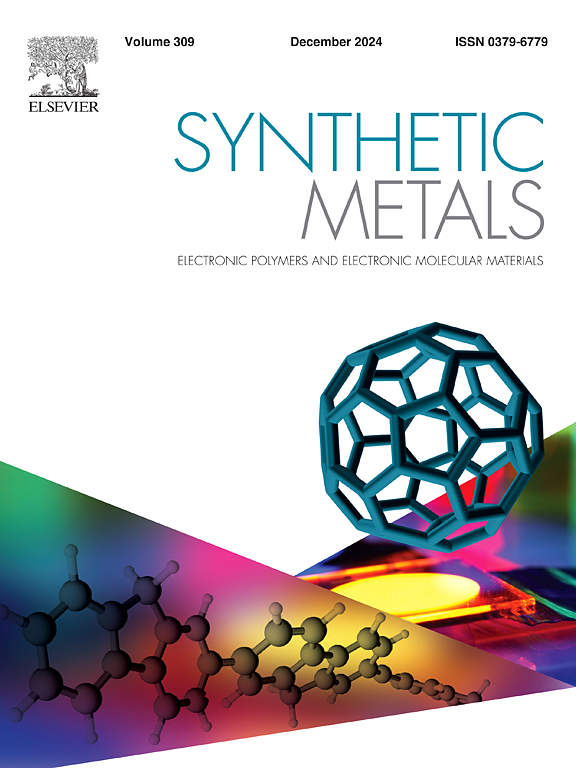三萜烯(TPC-X)中取代基的大小对层状二维有机金属(MDABCO+)(C60•−)(TPC-X)磁性和导电性的影响,其中X = H, Br和I
IF 4.6
3区 材料科学
Q2 MATERIALS SCIENCE, MULTIDISCIPLINARY
引用次数: 0
摘要
中性三甲烯TPC-X分子通过增加第9位X取代基的大小从X = H到Br和I的改性影响了(MDABCO+)(C60•−)(TPC-X)盐的磁性和导电性(分别为1-3),其中MDABCO+是n -甲基重氮杂环辛烷。这些盐具有由C60•−组成的六方富勒烯层,由于TPC-X的空间分离,它们保持未二聚。两个不同的富勒烯层,A层和B层,它们的环境不同。计算出的带宽为0.133 ~ 0.141 eV,表明两层富勒烯都接近莫特绝缘状态。只有一种类型的富勒烯层在2和3中表现出金属导电性,而另一种类型的富勒烯层具有局域电子态,并且在低温下表现出强的反铁磁自旋耦合。2和3的磁耦合遵循二维六边形层的Heisenberg模型,J分别为−28和−34 cm−1。二维金属导电性使得从2和3取向单晶中观察到戴森型电子顺磁共振信号成为可能,类似于1。在300 K以上加热2和3降低了它们的A/B比,在350 K以上达到统一,标志着过渡到非金属状态。加热后,间富勒烯中心到中心(ctc)距离增加,实质上减少了(MDABCO+)(C60•−)(TPC-X)中的重叠和转移积分。由于这些盐是窄带金属,因此ctc距离的增加可能会使这些金属转变为莫特绝缘状态。本文章由计算机程序翻译,如有差异,请以英文原文为准。
Effect of the size of the substituents in triptycene (TPC-X) on the magnetic and conducting properties of the layered 2D organic metals (MDABCO+)(C60•−)(TPC-X), where X = H, Br, and I
Modification of the neutral triptycene TPC-X molecule by increasing the size of the X substituent at the 9th position from X = H to Br and I affects the magnetic and conducting properties of the (MDABCO+)(C60•−)(TPC-X) salts (1–3, respectively), where MDABCO+ is N-methyldiazabicyclooctanium. These salts feature hexagonal fullerene layers composed of C60•−, which remain undimerized owing to spatial separation by TPC-X. Two distinct fullerene layers, A and B, differ in their surroundings. The calculated bandwidth of 0.133–0.141 eV for 3 indicates a narrow band nature and as a result both fullerene layers are close to a Mott insulating state. Only one type of fullerene layers demonstrate metallic conductivity in 2 and 3, while another type of fullerene layers have localized electronic state and shows strong antiferromagnetic spin coupling down to low temperatures. Magnetic coupling in 2 and 3 follows the Heisenberg model for 2D hexagonal layers, with J =−28 and −34 cm−1, respectively. The 2D metallic conductivity enables the observation of a Dysonian-type electron paramagnetic resonance signal from oriented single crystals of 2 and 3, similar to 1. Heating 2 and 3 above 300 K decreases their A/B ratio, reaches unity above 350 K, signaling a crossover to a nonmetallic state. The interfullerene center-to-center (ctc) distances increase upon heating, essentially reducing overlap and transfer integrals in (MDABCO+)(C60•−)(TPC-X). Because these salts are narrow-band metals, such an increase in ctc distances may drive a transition of these metals to a Mott-insulating state.
求助全文
通过发布文献求助,成功后即可免费获取论文全文。
去求助
来源期刊

Synthetic Metals
工程技术-材料科学:综合
CiteScore
8.30
自引率
4.50%
发文量
189
审稿时长
33 days
期刊介绍:
This journal is an international medium for the rapid publication of original research papers, short communications and subject reviews dealing with research on and applications of electronic polymers and electronic molecular materials including novel carbon architectures. These functional materials have the properties of metals, semiconductors or magnets and are distinguishable from elemental and alloy/binary metals, semiconductors and magnets.
 求助内容:
求助内容: 应助结果提醒方式:
应助结果提醒方式:


